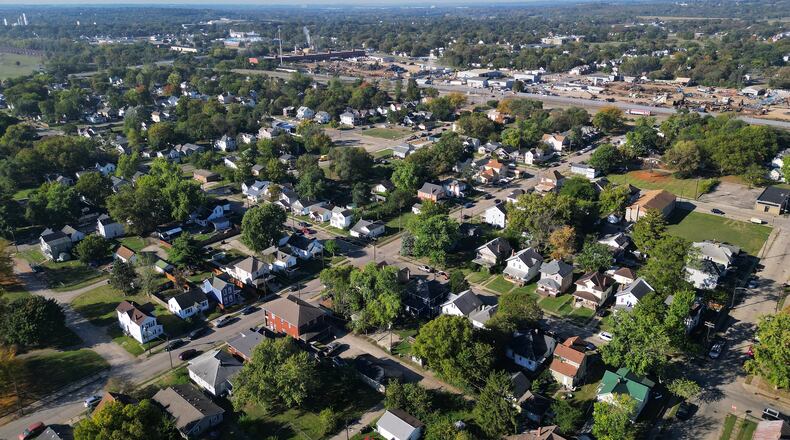“You’ve got your taxes, you’ve got your electric bill, groceries are high,” she said of the financial squeeze her family feels.
Wright is far from alone.
Wright lives in Lemon Twp., south of Middletown, one of numerous communities across southwest Ohio where skyrocketing property values sent property taxes soaring after the 2023 triennial update. And another large increase is likely on the horizon.
As state lawmakers debate how to give property owners like Wright relief, one place to start is looking at how one community’s taxes went up an average 32% without any vote from residents.
It’s the same thing contributing to the largest unvoted tax increases across southwest Ohio: A quirk in state tax law called the 20-mill floor.
“We have been screaming from mountaintops, that’s what needs capped,” Clark County Auditor Hillary Hamilton told this news outlet, referring to calls from county auditors across the state to address the 20-mill floor.
Increases on horizon
Ohio’s county auditors adjust property values every three years. The 2023 triennial reappraisal update produced average countywide value increases of 37% in Butler, 30% in Greene and 34% in Montgomery counties. Another adjustment is due next year.
Butler County Auditor Nancy Nix warns very early predictions are values could increase 13% to 25%, as of January 2026 to be paid the following year.
Montgomery and Greene counties are on the same cycle as Butler County. An official from the Montgomery County Auditor’s Office noted in a recent interview that Union County recently saw a countywide average increase of 27%, and that kind of number “is what we’ve been seeing for other counties.”
Clark County is currently going through the process and Hamilton is bracing property owners for a 32% average countywide value increase. This is an average, with lower increases in some areas and higher ones in “hot pockets” — she mentioned New Carlisle and Pleasant, Harmony and Moorefield townships.
“The sales in those areas are unbelievable,” she said.
20-mill floor
While property taxes are linked to property values, Ohio lawmakers decades ago tried putting measures in place to prevent a red-hot housing market like we are seeing now from causing crippling property tax increases. This law lowers the tax rate for most voted levies so they collect the same amount of money as values rise.
Credit: Alexis Larsen
Credit: Alexis Larsen
But for schools, there is a limit to how low it can go. This is the 20-mill floor. If a school district’s total millage — or tax rate — hits that floor, any growth in property values will create a corresponding increase in taxes.
Ironically, this means that school districts where residents have passed fewer levies have the potential to see the largest automatic tax increases.
After the 2023 appraisal, the average countywide residential tax increase in Montgomery County was 5.8%. But in school districts below the 20-mill floor the average hikes ranged from 8% to 16%. Farmersville and New Lebanon had the largest average tax increases without voter approval at 13.8% each.
In Greene County, all but Bellbrook’s schools are at the floor. Only two Butler County school districts are above the 20-mill floor, Fairfield and Lakota. Communities in those counties saw larger increases than Montgomery County.
Every school district in Clark County is at the 20-mill floor. Hamilton said it’s unclear exactly what this will mean for taxpayers after the current reappraisal, but “They’re going to pay more.”
Monroe Local Schools is at the 20-mill floor.
Monroe Schools did not respond to questions from this news outlet about how the 20-mill floor impacts their budget, but tax records show general property tax collections for the district increased nearly $1.9 million to $12.8 million since 2022 despite not passing any new taxes.
Other area districts have seen huge windfalls from the 20-mill floor. Greene County schools at the 20-mill floor were projected to get tens of millions of dollars combined last year because of rising property values.
‘To a point’
Monroe Schools wasn’t solely responsible for Wright’s taxes going up. Other distributed taxes went up nominally, by $1-$70 for Butler County, Lemon Twp., Butler County Joint Vocational School District, MetroParks of Butler County and Midpointe Library Systems.
| Taxes paid in 2023 for tax year 2022 | Taxes paid in 2024 for tax year 2023 | ||
|---|---|---|---|
| Butler County | $380.83 | Butler County | $403.26 |
| Lemon Twp. Exc Monroe Corp | $306.91 | Lemon Twp. Exc Monroe Corp | $373.22 |
| Monroe Local Schools | 2,071.10 | Monroe LSD | 2,710.90 |
| Butler County JVS | $96.46 | Butler County JVS | $139.19 |
| MetroParks of Butler County | $39.31 | MetroParks of Butler County | $40.92 |
| Midpointe Library Systems | $29.01 | Midpointe Library Systems | $30.15 |
| Assessments | $13 | Assessments | $13 |
| Total | 2,936.62 | Total | 3,710.64 |
This is due to numerous factors. Joint vocational schools have a similar, 2-mill floor. Some governments also collect an “inside” millage that also floats with property values. And there are normal adjustments that take into account things like new construction.
Also, former Butler County Auditor Roger Reynolds “suppressed” value increases in certain areas during the Great Recession in an effort to protect taxpayers from tax increases during a foreclosure crisis. During the 2020 reappraisal Reynolds told the Journal-News the Middletown area was one of the hardest hit and he readjusted accordingly.
“Middletown values went up a decent amount this time around,” Reynolds said. “Middletown over the last 12 years saw when the Great Recession hit, we reduced Middletown’s property values more than any other in the county because they saw the hardest impact from the downturn in the economy. Over time we’ve continued to increase those Middletown values up to current market.”
This, coupled with the pandemic-induced inflation caused larger-than-usual value increases in the Middletown area, said current Auditor Nancy Nix. Average values in Lemon Twp. skyrocketed 50% after the 2023 reappraisal.
As values shot up, so have taxes. The lion’s share of the increase in Wright’s tax bill is school taxes. And the primary reason for that increase is the 20-mill floor, according to Nix.
The amount Wright paid Monroe Local Schools is $659 higher this year than in 2023.
All of Wright’s five children attended Monroe schools at some point, but only one graduated from Monroe. The other four graduated through homeschooling.
“I can support schools, to a point,” she said.
Wright said she did not vote yes on the most recent Monroe Local School District levy, which passed with 64% of the vote and will not begin to be collected until 2029.
Far-reaching proposals
There have been multiple proposals by state leaders to address property tax increases, but little actual progress.
The most radical bill to-date is House Bill 335, dubbed the “Property Tax Relief NOW Act” and authored by former Ashtabula auditor Rep. David Thomas. He was named the chief architect of property tax reform by Republican House leadership.
It would completely erase inside millage and save property owners $3.5 billion, forcing local taxing bodies to use other resources to provide services and cut spending.
This news outlet asked Thomas whether they had taken into account there are many areas of the state that do not have strong income or sales tax bases to support this new burden. He said property taxpayers — much like Wright — are “tapped out.”
Credit: Barbara J. Perenic
Credit: Barbara J. Perenic
“The taxpayers don’t have the ability to come up with continued unvoted increases that we have seen over the last five years,” he said. “My constant response has been those entities are raising money through these unvoted means with spikes in values and that’s what’s led to the breaking of the system. That’s why we need to diversify, get out of just relying on the property tax bucket to fund our services.”
The measure hasn’t received much support and was not included in the biennium budget. The legislature inserted five reforms into the budget and Gov. Mike DeWine vetoed four of them. Thomas has told this media outlet he is working on a revised inside millage bill.
Finding meaningful tax reforms has become even more urgent since the Committee to Eliminate Property Taxes, a citizens group based in Cuyahoga County, is gathering petition signatures trying to pass a constitutional amendment eliminating property taxes altogether.
‘The best way’
Along with the vetoes DeWine convened a group to study the issue. This is the second group to do so; a prior lawmaker group discussed reforms and passed nothing.
DeWine’s study group until Sept. 30 to produce recommendations for meaningful property tax reform.
Legislators have introduced two bills that take a direct aim at the 20-mill floor issue. DeWine’s group is getting behind one of them, House Bill 186.
The measure would limit increases in property tax revenues for school districts at the 20-mill floor to the three-year average rate of inflation.
H.B. 186 has had four hearings in the House Ways and Means Committee and is a favorite with the group.
Credit: Nick Graham
Credit: Nick Graham
Warren County Auditor Matt Nolan, who is president of the County Auditors Association of Ohio, is a committee member and told the group this was the CAAO’s idea, “the capping of growth on the 20-mill floor is the best way to stop these dramatic increases in taxes without a vote.”
“The increase that we saw in property taxes was substantial,” he said.
‘I’m paying that’
When asked if she is worried about the tax increase, Wright said: “If it keeps going up, yeah.”
Wright and her husband bought their 1,400-square-foot home and its four acres of land in 1998 for $84,000.
Now, the home and land is valued at $234,490, an increase of about 10% each year for 27 years.
Wright does not work; her husband works as a facilities manager. Two of her five children no longer live at home.
Wright said though the bills are high, her family is “fortunate” and can pay them.
When asked if she would support abolishing property taxes, she said it depends on what the “alternative source” for the income might be.
“It’s gotta come from somewhere,” she said. “Obviously, we’ve got to support our government, and we’ve got to support schools.”
She said neighbors nearby have recently sold their houses and land for between $650,000 and $700,000. Years ago, when some of Wright’s friends moved to Mason, she saw their property tax payments, and thought “I could never afford that.”
“Now, here we are, and I’m paying that,” she said.






